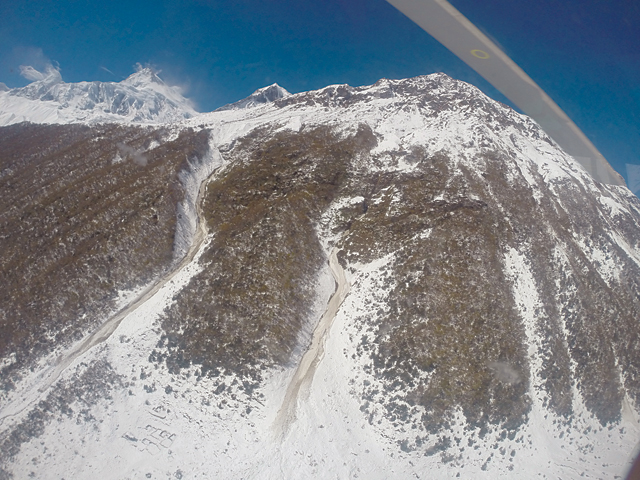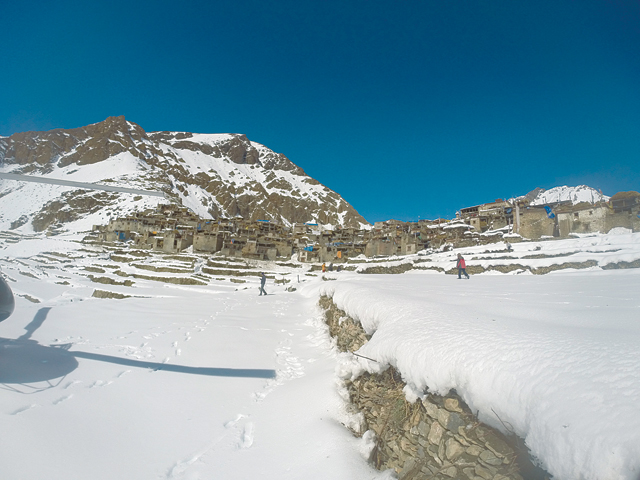As harrowing accounts of loss were emerging after the blizzard that swept through the Annapurna and Manaslu regions last month, a few groups of individuals continued to toil in the same harsh conditions in the hopes of saving the stranded lives. The following is a brief account of various efforts following the disaster.

The initial pictures of snowfall on Facebook of Manang Gaon as “the first snowfall of the season” was an aberration that caught the attention of Prakash Adhikari. The managing director of Himalayan Rescue Association (HRA) was having the usual day at the office before the prescient pictures surfaced. Slightly alarmed, he made a few calls to people in the location and to higher-ranking members of the organization. Before long, Adhikari’s fears were confirmed with a call from the Israeli Embassy reporting a handwritten message. It was reportedly from a group of Israeli trekkers who had taken shelter at a teashop on top of Thorong La Pass after being caught in the middle of a severe snowstorm. The message was found on a donkey’s back by porters.
 Immediately after, a meeting was held between the Ministry of Tourism, the Nepalese Army, Nepal Police, Trekking Association of Nepal (TAAN) and HRA to bring the crisis to attention. The area of the blizzard turned out to be much wider than previously thought. It expanded through most of the western mountain regions that include Manang, Mustang, and Dolpo districts, as well as Upper Gorkha—covering major portions of several trekking routes in the Annapurna region. The hardest hit with the most numbers of possible casualties was believed to be the trail leading upto Muktinath from Thorong La pass, where the Israeli trekkers were also stranded. The army in the Jomsom basecamp had already been informed by the Israeli Embassy, where rescue plans were already being drawn.
Immediately after, a meeting was held between the Ministry of Tourism, the Nepalese Army, Nepal Police, Trekking Association of Nepal (TAAN) and HRA to bring the crisis to attention. The area of the blizzard turned out to be much wider than previously thought. It expanded through most of the western mountain regions that include Manang, Mustang, and Dolpo districts, as well as Upper Gorkha—covering major portions of several trekking routes in the Annapurna region. The hardest hit with the most numbers of possible casualties was believed to be the trail leading upto Muktinath from Thorong La pass, where the Israeli trekkers were also stranded. The army in the Jomsom basecamp had already been informed by the Israeli Embassy, where rescue plans were already being drawn.

Four days have passed since the blizzard caused by the tail-end of the cyclone Hudhud that moved through the Bay of Bengal before hitting the region. The figures are still coming in; at the time of this story, the count was already up to 35 casualties. Several hundreds have been rescued, including the Israeli trekkers trapped in the tea shop. Most trekkers who managed to find shelter survived the storm, but most others who risked finding their way to safety were not so lucky. Surprisingly and alarmingly no one seems to know the exact number of trekkers, guides and even the locals present in the region when the storm hit, but the estimation goes into the hundreds. Rescue efforts are still underway.

The Chief District Officer of Mustang District, Baburam Bhandari who is incharge of the rescue operations in the district, shares that almost a thousand security personnel, including the Nepalese Army, the Armed Police Force and the Nepal Police, have been deployed in Mustang alone. From his statements, three individuals, two Swiss and a Nepali, have been rescued and two dead bodies were retrieved today. A total of 171 individuals have been rescued in the district since the onset. The first round of search and rescue efforts have just been called to an end, having scanned the trails through the district with chances of finding more survivors down to single digit percentiles. After this, only direct rescue operations will be made as a response to reports of particular missing individuals. Rajendra Raj Regmi, DSP, Nepal Police, who is involved in rescue efforts in Manang, shares a similar story from the area. On the day, 46 had been rescued and a body had been retrieved. He reports the weather to be deteriorating again. However, rescue efforts are to continue for two more days.

Meanwhile in Kathmandu, the same evening, Simrik Air pilot and Operations Manager Siddhartha Gurung, medical doctor Nima Namgel, rescuer Lakpa Norbu Sherpa and Chhering Dhenduk Bhote, along with a New Zealander pilot Jason Andrew Laing are meeting at Radisson Hotel’s Corner Bar in Lazimpat to discuss the rescue efforts for tomorrow. The group is discussing possible locations of a small group of Italian trekkers who have not yet been located. They are one of the several other rescue teams that include private-helicopter pilots, trekkers, and mountaineers who are also actively involved in the rescue efforts. Gurung flies one of the rescue helicopters among around seventeen other choppers including two army helicopters that are in operation for the rescue.

Early next morning Gurung will be making a fifty-minute flight to Ringmogaon in Phoksundo from Tribhuvan airport. After picking up a few people there and some supplies, Gurung will fly to several locations in the region, including Charka Boht, DHO Tarap and other villages nearby, following trekking routes in lookout for trails that could lead to stranded trekkers.
Every year more than a hundred thousand trekkers traverse through the trekking trails of Nepal’s Himalaya. Lured by the extraordinary beauty and perhaps deep reverence for the mountains, the travellers pass these trail for reasons scaling from adventure to transcendence. However, at times these mountains can be a humbling reminder of our own fragility.
The losses that were suffered from the blizzard will forever be a sad reminder, but hopefully with perseverance, lessons will be sought to avert such tragedies in the future.











